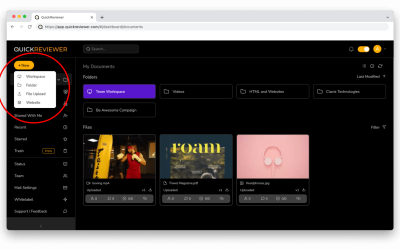What is a Collaboration Tool? The goal of a collaboration tool is to improve cooperation efficiency by offering a central platform for employees to freely exchange information, data, and documents in order to solve specific business problems or finish creative initiatives. Members of the team may collaborate from anywhere in the cloud, stimulating creativity and speeding up work to increase profitability and corporate development.
The best online collaboration software makes it simple for teams to work together on a variety of general and specialized tasks.
Collaboration is the new normal in the workplace, and employees are no longer expected to work alone. This focus on cooperation should lead to increased efficiency and output, but only if the correct tools are employed in the first place.
These services may range from cloud document storage to video conferencing for online meetings, and they’d be available on both mobile devices and desktops and laptops.
Above all, everything should be easy to use, understand, and devoid of ambiguity. Everyone in the firm, regardless of their status, should be able to speak with the appropriate person about the same issue. Then, using the appropriate technique, address the issue.
Let’s take a look at some of the best collaboration tools in recent times.
QuickReviewer: QuickReviewer is an online proofing tool for designers, web developers, and marketers who wish to collaborate on design projects more rapidly and obtain quicker feedback and approval. It is a great collaborative tool as it makes the online proofing process very simple and remote. It aids in the examination of images, videos review tool, live web links, HTML, PDFs, and audios. QuickReviewer’s mobile-responsive UI allows users to study and approve files on their mobile devices. QuickReviewer makes organizing comments on creative work easier by removing the need for many emails or files. Users can add comments by highlighting text, pointing out changes, or sketching changes, and comparing versions side by side. Adding real-world links or dragging and dropping HTML zip files to test designs on different screen widths, animated HTML banners, responsive web pages, and more will make creative collaboration a breeze.

Zoom: Many businesses have “used Zoom” for years, but it would have been difficult to forecast how important this technology would become in the modern workplace before 2020. Teams utilize Zoom for group meetings and virtual activities, and it is currently the market’s top video conferencing solution. Zoom is really simple to use, which is why so many people are utilizing it to chat with their friends and family these days. To begin a video conference, just create a Zoom meeting in the app and invite the people you want to join. Even better, for calls under 40 minutes and with 100 participants, Zoom is completely free. It has breakout rooms for breaking up large calls into smaller, more manageable groups, integrations with a variety of tools and apps (such as Zoom and Hive! ), interactive meeting features such as filters, reactions, polls, hand-raising, and more, connectivity with calendars on Gmail, Outlook, or iCal, meeting recording and transcription, and chat with individuals and/or groups within meetings.
Google Slides: It’s a fantastic team collaboration tool for creating, editing, collaborating on, and presenting slideshows from anywhere. The Google Workspace business plan option elevates the standard Google Slides tool to new heights. Teams may get more safeguards and controls over presentations with this plan, making internal and external collaboration even easier. With pre-made pitches, portfolios, and other presentations, templates make it simple to get started. You may access documents stored in the cloud from anywhere. Options for offline editing and presentation The auto-save option ensures that your work is not lost. Within presentations, real-time editing, commenting, and talking are possible. You can share with anyone (internally or outside), with a range of permission choices .
Slack: For organizations of all sizes, this technology is one of the most popular instant messaging and collaboration platforms. Slack brings all aspects of professional communication together in one place, including features such as direct messaging, group messages, channels, phone calls, and video calls. These many communication alternatives can assist your team in organizing interactions and focusing on the tasks that are most essential to you. It allows you to choose whether to make channels and groups public or private. Slack Connect allows you to collaborate with numerous companies in one channel and has a searchable history, even if projects or channels are no longer active.
ProofHub : With ProofHub all of your communication, collaboration, and project management activities are centralized with one platform. ProofHub can let you collaborate on files, communicate, exchange real-time feedback, and keep your work life organized with its strong features. ProofHub also interacts with popular tools you currently use, allowing you to access everything from any one location. It has custom workflows and kanban boards, project planning with Gantt charts and project timelines, different project views (table view, timeline view, board view, calendar view), a dedicated place for real-time conversations, and a group chat tool, among other features. It’s also accessible for Android and iOS as a browser and mobile app.
Bit.ai: Bit.ai is one of the greatest and most powerful document collaboration platforms on the market, allowing teams to collaborate on dynamic notes, papers, deliverables, wikis, and training materials, among other things. These collaborative documents are sleek and well-designed, with the ability to transition seamlessly from text to video, spreadsheets, and more. Users can combine components in an infinite number of ways. Users may co-edit and comment on components in real time once they’ve entered a document.
Dropbox Paper: Dropbox Paper, like Google Drive, allows you to collaborate in real time on your saved files and papers. However, it goes a step further by assisting users in planning projects, collaborating on ideas, and taking real-time meeting notes with assigned next tasks. DropBox is beneficial to teams who currently use other project management solutions since it interacts effortlessly with Hive and other platforms.
Brandfolder: With Brandfolder, you can upload, store, organize, and share an endless number of files in a safe area, with several degrees of security. There are also drag-and-drop and bulk upload options. Partners can contribute files as guests without having full access. It can handle a wide range of file kinds, including photos, video, audio, and documents. Google Analytics, Salesforce, HubSpot, WordPress, Adobe Creative Suite, and Microsoft Office are among the creative tools it can interact with.
MindMeister: Visualizing data, organizing projects, and brainstorming ideas are all made easier using mind mapping and collaboration tools like MindMeister. Using pre-set map themes or customized maps with colors, styles, formatting, and pictures that best suit your needs, this application allows teams to communicate and exchange ideas in real time.
Hugo: During the note-taking and editing process, this application allows team members to communicate in real time. Then, for actionable next actions, tasks may be given to particular personnel. It interacts with many of your team’s existing tools, allowing you to keep everything organized and linked. It is a calendar-based application. Meeting links between Microsoft Office 365 and Google. It comes with real-time multi-user note editing, shared meeting agendas, and agenda templates to help you set the tone for effective meetings. It also works with over 20 different apps, including Slack, Zoom, Jira, and Hubspot.
Jostle: Jostle has capabilities such as the ability to exchange files, send messages, and commemorate significant milestones or special occasions. Teams can stay connected and feel like they’re in the office with Jostle, even if they’re working from home. It contains an activity feed to stay up with the latest corporate news, tailored announcements for specific groups or teams, discussion boards to connect people and teams, a library to store critical company papers and rules, and the ability to exchange files and assign tasks to team members.
Conclusion
Employees from all around the world are increasingly collaborating on the same project. The shift to a more scattered workforce is gaining attraction, demanding online collaboration. Online collaboration tools are being used to overcome geographical gaps between employees, organize successful meetings, and ensure that everyone is on the same page at the same time. This will help to speed up work completion and improve employee communication.
Some other Posts you might be interested in.
Transforming the quality of online education using review tools
Using Video Review Tools to Elevate Course Content Quality in Online Learning In the dynamic realm of online education, the quality of course content is a key determinant of the learning experience for students. As educators strive to deliver engaging and effective...
How sweet the sounds of success—Spreading Christmas Cheer with QuickReviewer
Unwrapping Creativity: A Christmas Miracle with QuickReviewer!" Ho, ho, ho, dear readers! Gather 'round as I share a tale of holiday magic, tight deadlines, and a dash of ingenuity with QuickReviewer. As a seasoned creative elf, I found myself face-to-face with the...
Top 5 Review and approval software alternatives to Ziflow in 2023
The digital age has revolutionized how we collaborate, especially in design and content creation. Review and approval processes are crucial in ensuring that projects meet the desired standards before they're finalized. Ziflow has been a popular choice for many when...




